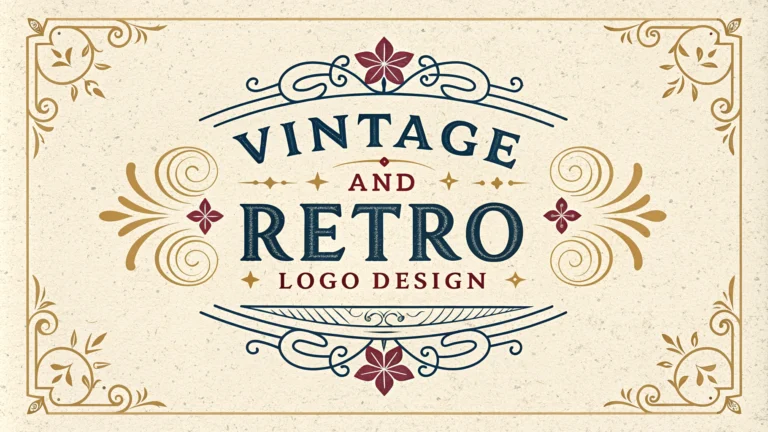A well-designed vintage or retro logo can give your brand timeless appeal and help it stand out in today’s marketplace.
Key Elements of Vintage Logo Design
Classic vintage logos often incorporate ornate details, hand-drawn elements, and typography inspired by historical periods.
- Distressed textures and weathered effects
- Badges, banners, and emblems
- Decorative borders and flourishes
- Serif fonts and script typefaces
- Monogram-style designs
Color Schemes for Retro Logos
Traditional vintage color palettes typically include:
- Muted earth tones
- Sepia and faded effects
- Black and cream combinations
- Dusty pastels
- Rich burgundies and navy blues
Popular Vintage Style Periods
| Era | Characteristics |
|---|---|
| Victorian (1837-1901) | Ornate details, elaborate typography |
| Art Deco (1920s-30s) | Geometric patterns, bold lines |
| 1950s Americana | Badge designs, script fonts |
Design Tools and Resources
Professional designers typically use these tools for creating vintage logos:
- Adobe Illustrator – Download
- Affinity Designer – Download
- RetroSupply Co. – Vintage textures and brushes
Quick Tips for Authentic Vintage Designs
- Research historical references from your chosen era
- Use appropriate typography for the time period
- Add subtle texture and wear effects
- Keep layouts symmetrical and balanced
- Include classic design elements like stamps and seals
Common Mistakes to Avoid
- Mixing elements from different time periods
- Overusing distressing effects
- Choosing inappropriate modern fonts
- Making the design too complex
Test your vintage logo design in different sizes and applications to ensure it remains legible and effective across all uses.
File Formats for Logo Delivery
- AI/EPS – Vector source files
- PDF – Print-ready format
- PNG – Web/digital use with transparency
- JPG – Standard image format
Consider creating both full-color and single-color versions of your vintage logo for different applications.
Working with Clients on Vintage Designs
Effective communication with clients is crucial when developing vintage-inspired logos. Establish clear expectations and gather detailed information about their preferred historical references.
- Create mood boards with period-specific examples
- Present multiple concept directions
- Document historical inspiration sources
- Explain design choices and symbolism
Adapting Vintage Logos for Modern Use
Digital Applications
- Social media profile pictures
- Website headers and favicons
- Email signatures
- Mobile app icons
Print Applications
- Business cards and letterheads
- Product packaging
- Signage and displays
- Marketing materials
Future-Proofing Your Vintage Design
Create logos that maintain their vintage appeal while ensuring long-term usability:
- Build scalable vector designs
- Maintain clean lines in key elements
- Create simplified versions for small applications
- Document color codes and font choices
Conclusion
Successful vintage logo design requires careful attention to historical accuracy, balanced with modern functionality. Focus on authenticity while ensuring the final design serves its contemporary purpose effectively. Remember to provide clients with all necessary file formats and usage guidelines to maintain the logo’s integrity across all applications.
Regular maintenance and updates may be necessary to keep the vintage design relevant while preserving its classic appeal. Consider creating a style guide to ensure consistent implementation across all brand touchpoints.
FAQs
- What defines a vintage or retro logo design?
A vintage or retro logo design incorporates visual elements, typography, and styles from past eras, typically from the 1920s to 1970s. These designs often feature distressed textures, classic color palettes, hand-drawn elements, and period-specific typography. - Which fonts are best suited for vintage logo designs?
Classic serif fonts like Clarendon, Bookman, and American Typewriter, as well as distinctive display fonts such as Cooper Black, Britannic, and Rockwell work well for vintage logos. Script fonts like Brush Script and Lobster are also popular choices. - What color schemes are typically used in vintage logos?
Vintage logos often utilize muted or desaturated colors, including cream, sepia, deep reds, navy blues, and forest greens. Monochromatic color schemes and duotones are also common in vintage design. - How can I achieve an authentic vintage texture in my logo?
Authentic vintage textures can be achieved through halftone patterns, subtle grain effects, letterpress impressions, and intentional imperfections like scratches or fading. Vector textures and overlay techniques can help create these effects digitally. - What are common elements used in vintage logo design?
Common elements include badges, banners, ribbons, ornamental borders, heraldic symbols, hand-drawn illustrations, crossed elements, establishment dates, and decorative flourishes. - How do I ensure my vintage logo remains legible at different sizes?
Design with scalability in mind by maintaining clear spacing, avoiding overly intricate details, and ensuring sufficient contrast. Test the logo at various sizes and create simplified versions for smaller applications. - What historical periods are most popular for vintage logo inspiration?
The Art Deco era (1920s-30s), Mid-Century Modern period (1940s-60s), and Victorian era (late 1800s) are particularly popular sources of inspiration for vintage logo design. - How can I make my vintage logo design feel authentic rather than cliché?
Research the specific time period you’re referencing, understand its design principles, and incorporate unique elements relevant to your brand. Avoid overusing common vintage elements and focus on originality within historical parameters. - What software is best for creating vintage logo designs?
Adobe Illustrator is the industry standard for logo design, particularly for vintage styles, as it offers vector-based design capabilities and extensive texture and effects options. Affinity Designer and Corel Draw are viable alternatives. - How do I maintain brand relevance while using a vintage design style?
Balance vintage elements with contemporary design principles, ensure the style aligns with your brand values and target audience, and consider incorporating modern touches that make the logo feel timeless rather than dated.








